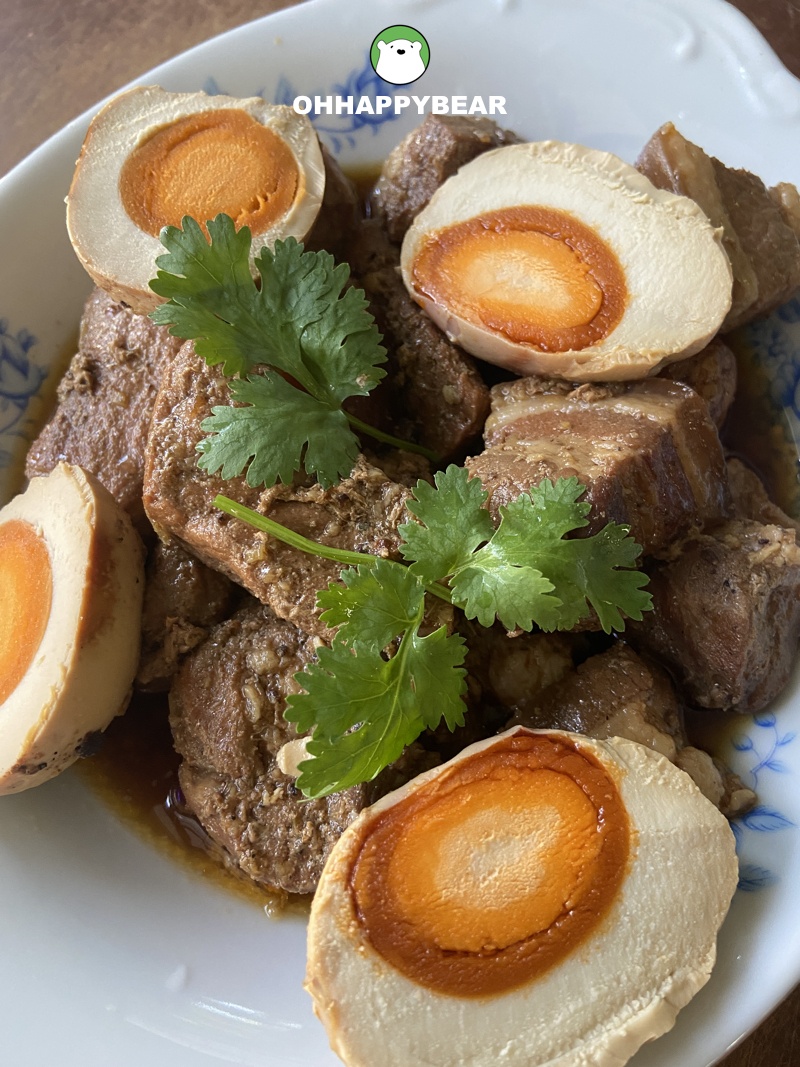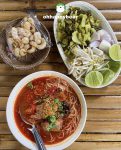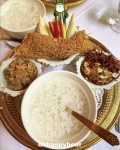This is an easy recipe anyone who wants to tuck into something homey and delicious any time of the week should definitely have in their repertoire. The dish might look intimidating, being a rich stew with countless adaptations and all, but trust me, once you get a hold of it, you will forever be a master of it.
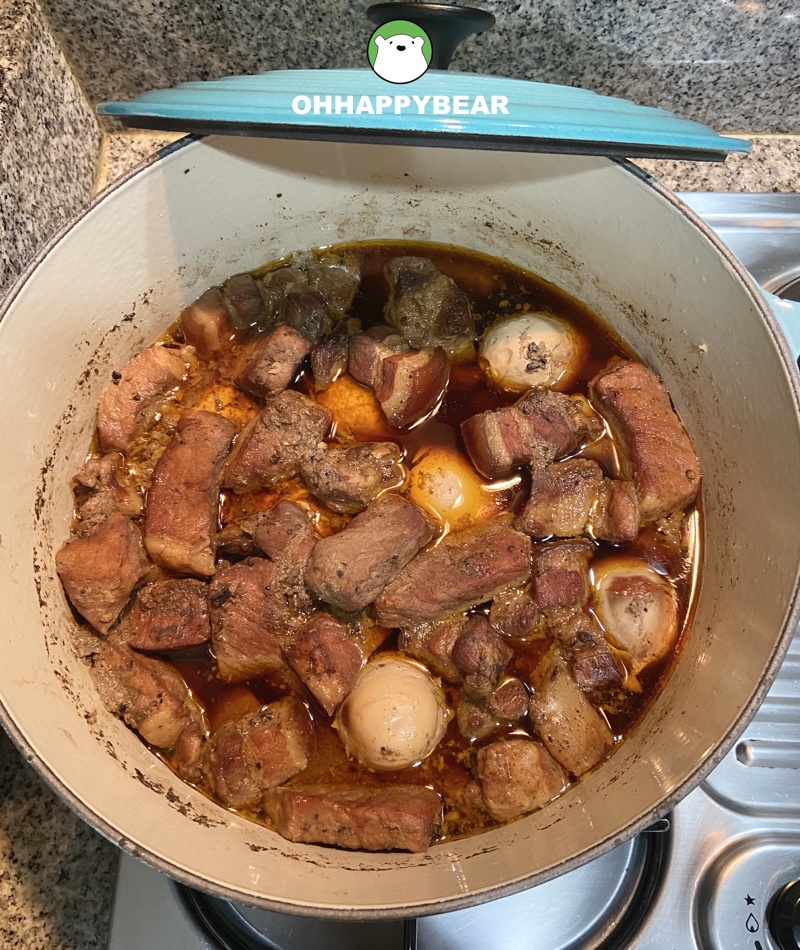 Above: My latest pot of Moo Hong with salted eggs from Chiya District of Surat Thani replacing the usually called-for boiled eggs, preferably duck eggs.
Above: My latest pot of Moo Hong with salted eggs from Chiya District of Surat Thani replacing the usually called-for boiled eggs, preferably duck eggs.
This is my ‘Moo Palo’ or ‘Moo Hong,’ or ‘Moo Tom Khem,’ which is basically a stew of pork belly and eggs. The name differs depending on who calls it. In Bangkok, we call it ‘Palo’ and that’s that. But then, the variation of the recipes and ingredients differ this dish from one place to another. In Phuket and also in many parts of southern Thailand, this dish is a mainstay and it is called ‘Moo Hong.’ The differences that I know of are that Moo Hong is notoriously, or perhaps famously, made solely from pork belly. The glossy layers of fat on top are widely praised, enjoyed, and perpetuated into a classic. Also, a Phuket Moo Hong usually contains five-spice ingredients while Moo Palo or Khai Palo of Bangkok people might not.
“In Phuket, this dish is a mainstay and it is called ‘Moo Hong.’ The differences that I know of are that Moo Hong is notoriously, or perhaps famously, made solely from pork belly. The glossy fat on top is widely praised, enjoyed, and perpetuated into a classic.“
Before explaining further, I need to go back to my original Khai Palo making. Again, Khai Palo is the same thing as Moo Palo. This is because pork or pork belly and eggs are the usual pair of this dish. But sometimes we can skip the eggs, hence the name of ‘Moo (pork) Palo.’
The word ‘Palo’ means the five-spice. The cloves, the star anises, and the cinnamon sticks are toasted and grounded together into a mix and then added into the marinade. Of course, you can buy the five-spice powder, but I found grinding my own so much better. Not only that the freshly toasted and ground spices are obviously more aromatic, but, in the process, I can choose the better-looking ingredients, tossing away ones that seem to contain mold, etc…, before using them. My original Palo does not contain the five-spice powder though. As prominent as it is, the powder is not called for in a Thai-style Palo. The five-spice is something to add on if you like the aroma. But a Thai-style Palo only contains what Thai cooks call ‘Sam Kleur’ สามเกลอ: a mixture of three aromatics: garlic, cilantro roots, and white peppercorns that we use so much in the Thai cooking. Those three ingredients are all mixed and pounded into a smooth paste! This is the only thing you’ll need to make a Thai-style Palo. And a little bit of palm sugar to caramelise the whole thing into a sumptuous dark brown broth.
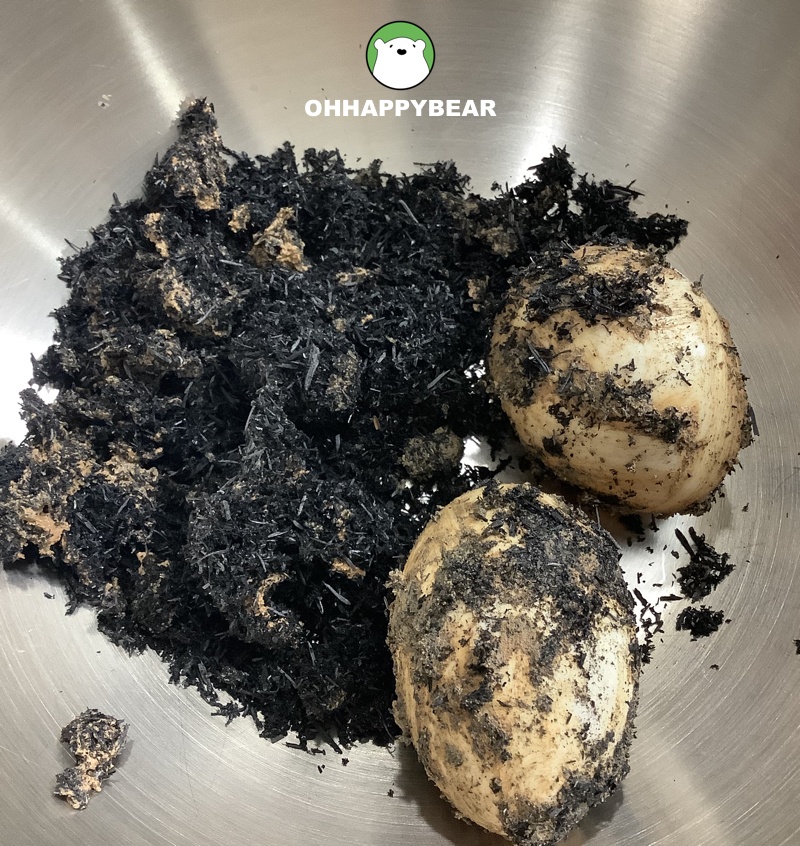
Above: Khai Khem Chaiya ‘unboxing.’ Usually, the duck eggs are each smothered with clay-salt mixture and ash. Clean everything off and boil the eggs until done. Don’t forget to gently move the eggs around while boiling to centre the yolks.
“But a Thai-style Palo only contains what Thai cooks call ‘Sam Kleur’ สามเกลอ: a mixture of three aromatics: garlic, cilantro roots, and white peppercorns that we use so much in the Thai cooking. Those three ingredients are all mixed and pounded into a smooth paste!”
I also reduce the ratio of pork belly. Instead of using 100% pork belly in my proportion, I use only 1 part of the belly to 2 parts of the sirloin. First, I toast that ‘Sam Kleur’ paste with oil until aromatic, then add two tablespoons of palm sugar, and let it caramelise before adding the pork, the water, and then the eggs, if called for at the time. For the eggs, I swap between hen eggs and duck eggs. I found that duck eggs are much denser, creamier, but at the same time gamier in their innate scent. Some people might not like it, but I am ok with it.
But fresh eggs are not the only way to go. Salted eggs can also be used and they make the whole thing even creamier, glossier, and, for me, more delicious. The thing is salted duck eggs, boiled, are very difficult to peel. I might have done it the wrong way, but still, it was a pain.
Salted eggs or Khai Khem ไข่เค็ม is another ingredient we adopted from the Chinese long long time ago. They are much more proliferated in Thailand than the thousand-year-old eggs. And you might already know the reason. They are easier to eat, delicious, and paired well with so many ingredients. It is something handy to have in the kitchen. Boiled until creamy, kept in the egg nooks in the fridge, ready to be cut into halves, and scooped out as the topping for plain rice porridge. BTW: Below is my previous IG post with steps of making a Moo Palo.
But not all Khai Khems are the same. In Chaiya District of Surat Thani, people heartily make Khai Khem as their special local souvenir. Driving past the district on the way back to Bangkok, one will see huge billboards boasting various roadside markets that are packed with Khai Khem of all names. Usually, Khai Khem Chaiya of my experience is sold fresh. Their boxes will be dated by the dates the eggs can be fried (less salty), and the dates that they should then be boiled (saltier). Frying salted eggs is a dedication. Be prepared to clean up. They splatter like their mother ducks never taught them manners.
A good Khai Khem, for me, is a fresh one. Despite being a preserved food, fresh Khai Khems are better, tastewise and all. The white is more tender and not too opaque, it looks not much unlike a normal boiled egg. The yolk of a salted egg, the highlight, is sheen with its red natural oil, a testament of its richness. A technique that I learned from someone who loves me enough to tell me is that you need to overboil the salted eggs in low heat to achieve that sheen. It might take about half an hour in all.
Moo Hong Phuket with chaiya salted eggs
Ingredients:
- One Kilo of pork (I used one part pork belly, two parts pork sirloin)
- Salted eggs (I used around 10-12 eggs), boiled to cook and peeled
- Sam Kleur paste: fresh garlic, cilantro roots, and white peppercorns (1:1:1 tablespoon) pounded until smooth
- One small cinnamon stick, one teaspoon cloves, 2 small star anises, toasted until fragrant and pounded into powder
- Two tablespoons of palm sugar (or to taste)
- Light and dark soy sauce to taste
Moo Hong Phuket calls for the five-spice powder, so I am including it here. But if you are making a simple non-fussy Palo, you can skip the ingredients.
In a deep pot, stir-fry the Sam Kleur paste until very aromatic (about 3 mins), then add the palm sugar. Let the sugar dissolve and caramelise. Too much sugar will toughen the pork, so don’t overdo it in this step. If you are to add more sugar to your liking, add it at the end.
When the sugar caramelises and all things get brown, add the pork and coat all the meat with the sauce. Add the eggs of your choice and gently coat the eggs. Add water to cover the whole thing and let it simmer away for an hour or two. This is a stew dish, so the more it is stewed, the more delicious it will be. I serve my Moo Hong with a big tray of fresh vegetables and tangy rice vinegar with pounded yellow chillies.
A LITTLE NOTE FROM US: If you are enjoying reading this blog, as we hope you all are, please kindly consider making a donation to charity causes listed HERE as a way to give us support. Your acts of kindness are always appreciated. Many thanks.
More Thai COOKING/RECIPES
Thai Omelette and my mother’s recipe
SOFT OMELETTE WITH SHRIMPS ไข่ข้นกุ้ง
Thai-Style Garlic Pork or Moo Tod Kratiem
How to Make Aiyu Jelly | โอ๊ะเอ๋วคืออะไร
3 Cooking & Eating Tips from Me #AtHome #StayHome
How to make an easy delicious chicken laksa
© OHHAPPYBEAR
